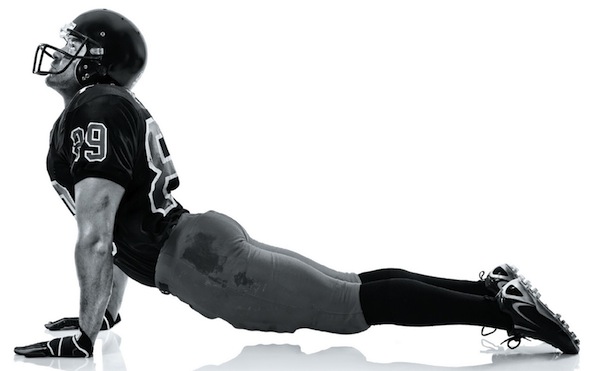More and more people are turning to yoga to help prevent and recover from injuries as doctors, physiotherapists and trainers are increasingly aware of the positive benefits of a long-term yoga practice. As yoga enters the sports arena (so to speak) it is becoming another key tool for athletes and those who are looking to maintain their fitness in a way that will complement their injury prevention or recovery plan.
In terms of injury prevention, yoga is an excellent way to stretch tired muscles and increase flexibility, focus and balance – all of which contribute to injury prevention in different ways. Flexibility helps to balance out your muscle strength, reduce resistance in tissue structures and increase the range of motion in your joints. Focus helps to keep your attention on the present moment – in daily life we go through a lot of mundane day to day activities that we can perform without much attention needed. By increasing your focus, you are less likely to mindlessly perform tasks that may cause injury, instead becoming present and focused on the task or action you are performing. Balance has been shown to reduce risk of injury in athletes as it advances an athlete’s ‘proprioception’ – their awareness of their body and how it moves through space. Within this understanding, balancing practices have been shown to reduce common injuries in athletes.
This ties in directly with the key ingredient of yoga, which is the mindfulness aspect that comes from a consistent practice. By learning to be mindful in movement you will be less likely to push through pain and therefore less likely to push your body into an injury. Patience can be a big part of injury recovery and moving slowly with the breath can increase your patience with your body and your mind. Moving slowly with the breath also means that you are only moving as fast as you are breathing and this encourages many people to slow their movement down. Sometimes people associate slower movement with less of a workout – it definitely doesn’t have to be that way. Certain yoga styles and teachers have a way of combining slow, purposeful movements with strength-building and fitness. Hatha is a great example – many people associate hatha yoga with relaxation but with some teachers this practice can be a slow but strength-building.
For injury recovery, this can obviously vary from person to person and you will need the advice of a physio to know exactly what you need for your particular injury. If your physio has recommended yoga – ask a few follow up questions to get an idea of what kind of yoga would be most beneficial. If your physio doesn’t know there is more than one type of yoga then ask what level of intensity would be good for your injury, and also if static stretches or more dynamic yoga would be best. Then select the style to match your recovery plan. Yin is generally good for relaxation and helping to ease the connective tissue between muscles which can help with flexibility, prevention and recovery – static stretching. Hot yoga, Flow, Ashtanga and other forms of more vigorous styles of yoga would suit more dynamic recovery plans.
As a general rule, the slower you move the less likely you are to injure yourself, or damage an old injury and you should never feel any physical pain in a yoga class. This makes yoga a safe and healthy way to get to know your body better, and to listen to its triggers and responses which adds huge value to your performance – in sports or in life.



